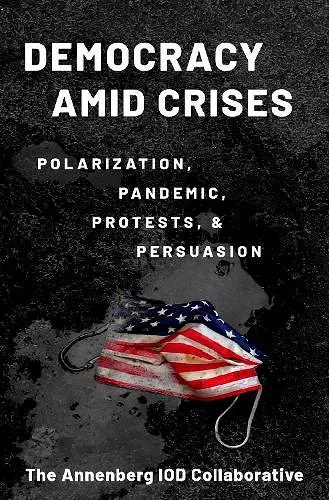Democracy amid Crises
Polarization, Pandemic, Protests, and Persuasion
R Lance Holbert author Josh Pasek author Daniel Romer author Matthew Levendusky author Andrew Renninger author Yotam Ophir author Bruce Hardy author Kate Kenski author
Format:Paperback
Publisher:Oxford University Press Inc
Published:12th Apr '23
Should be back in stock very soon
This paperback is available in another edition too:
- Hardback£80.00(9780197644690)

A data-rich analysis of how the four inter-related crises of 2020 -- the COVID-19 pandemic, the economic collapse and K-shaped recovery, the clashes over the legacy of racism and policing, and assaults on the legitimacy of democratic institutions (abetted by conspiracy theories) -- shaped not only the 2020 election, but also the future of our democracy. The 2020 election cycle was one of the most tumultuous in the nation's history. Early in the cycle, a global pandemic hit the US, paralyzing much of the economy and raising a multitude of questions about how people would go about voting. Then, beginning in late spring, a series of police brutality cases set off a nationwide wave of protests and civil disturbances related to racial justice concerns. In the final phase, the president of the United States refused to accept the results and incited his followers to storm the US Capitol. How did all of these momentous events shape voters' opinions? And what impact did they have on the outcome? To answer these questions, Kathleen Hall Jamieson and her collaborators surveyed 9,000 Americans over the course of the year to determine how voters reacted to the events on the ground, the campaigns' attempts at persuasion, and the post-election chaos that followed Biden's victory. Generally, American voters saw the multitude of crises through the lens of their polarized partisan predispositions. But why? Jamieson and her co-authors first stress that America has multiple electorates, and they are exposed to different informational environments. The divergent messages they received shaped not only their vote choice, but also how they made sense of these crises. Interestingly, though, while many voters were locked in place by their partisan priors, a majority of those who ended up voting for either Biden or Trump were unsure of their choice and whether they would actually vote at some point during the year. What led to both the wavering in people's choices and the attitudes they eventually adopted were in large part due to the differing media environments enveloping them: the messages from the campaigns, from their family and friends, as well from those in mass and social media. But this is not a simple story of "echo chambers," where individuals are immersed in only one type of...
The Annenberg team has produced an impressively comprehensive, multidisciplinary account of the 2020 election, shedding light not only on voters' choices but also on the unsettled state of American democracy. * Larry Bartels, Vanderbilt University *
In this book, a stellar team of scholars provides an exhaustive account of the 2020 election. After reading it, the 2020 election makes a lot more sense to me, though I now can't help wondering what it portends as the electorate and communications evolve here and abroad. It is a major and impactful work. * Christopher Wlezien, University of Texas at Austin *
This landmark book masterfully chronicles and analyzes the tumultuous events that unfolded during President Trump's final year in office. It is a must-read for anyone who cares about the health of our democracy. * Natalie Stroud, University of Texas, Austin *
The book's findings and arguments are eye-opening and scary. This is an important book for anyone who wants to better understand the 2020 election and the current and future state of American democracy. * Choice *
ISBN: 9780197644706
Dimensions: 157mm x 233mm x 20mm
Weight: 826g
488 pages